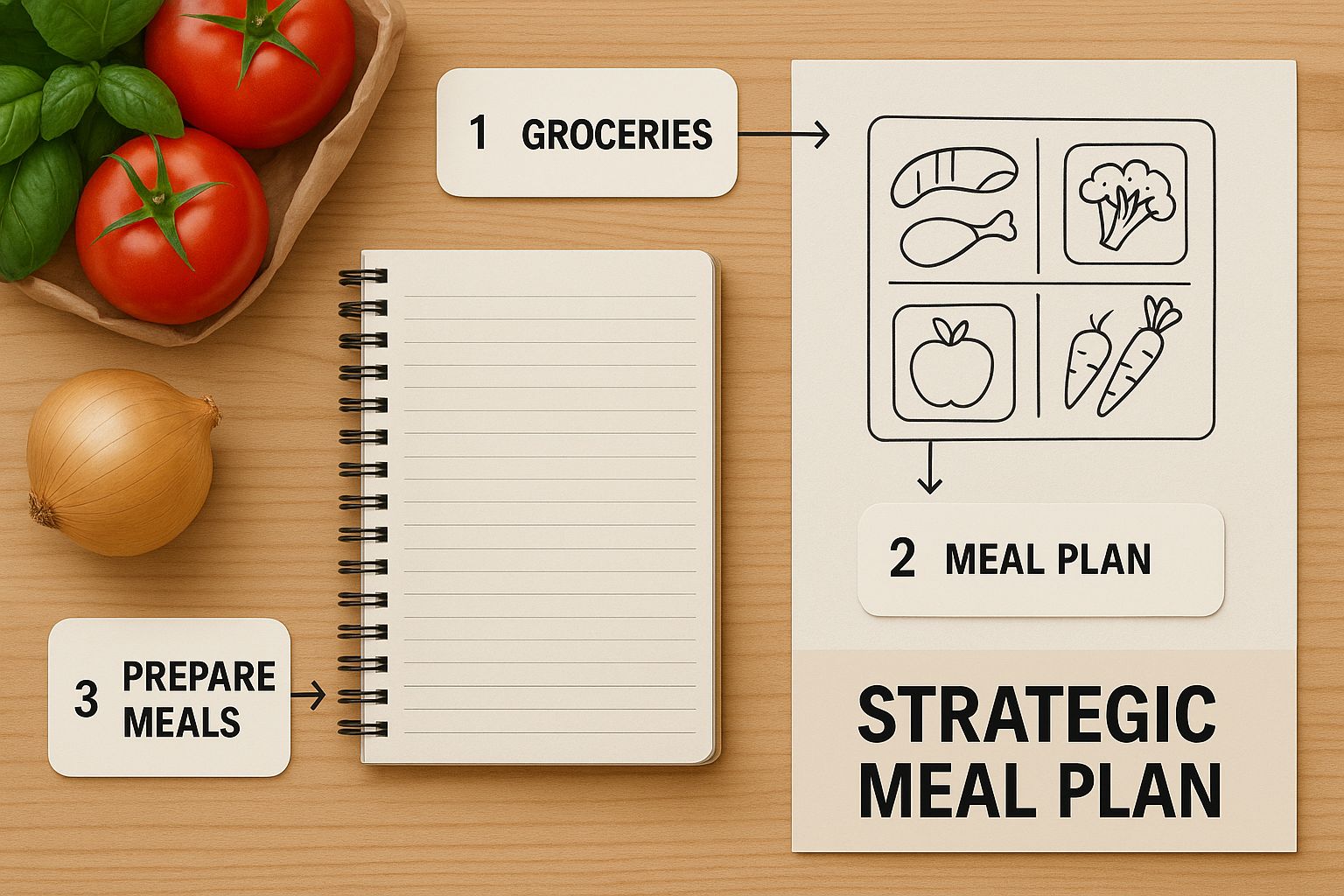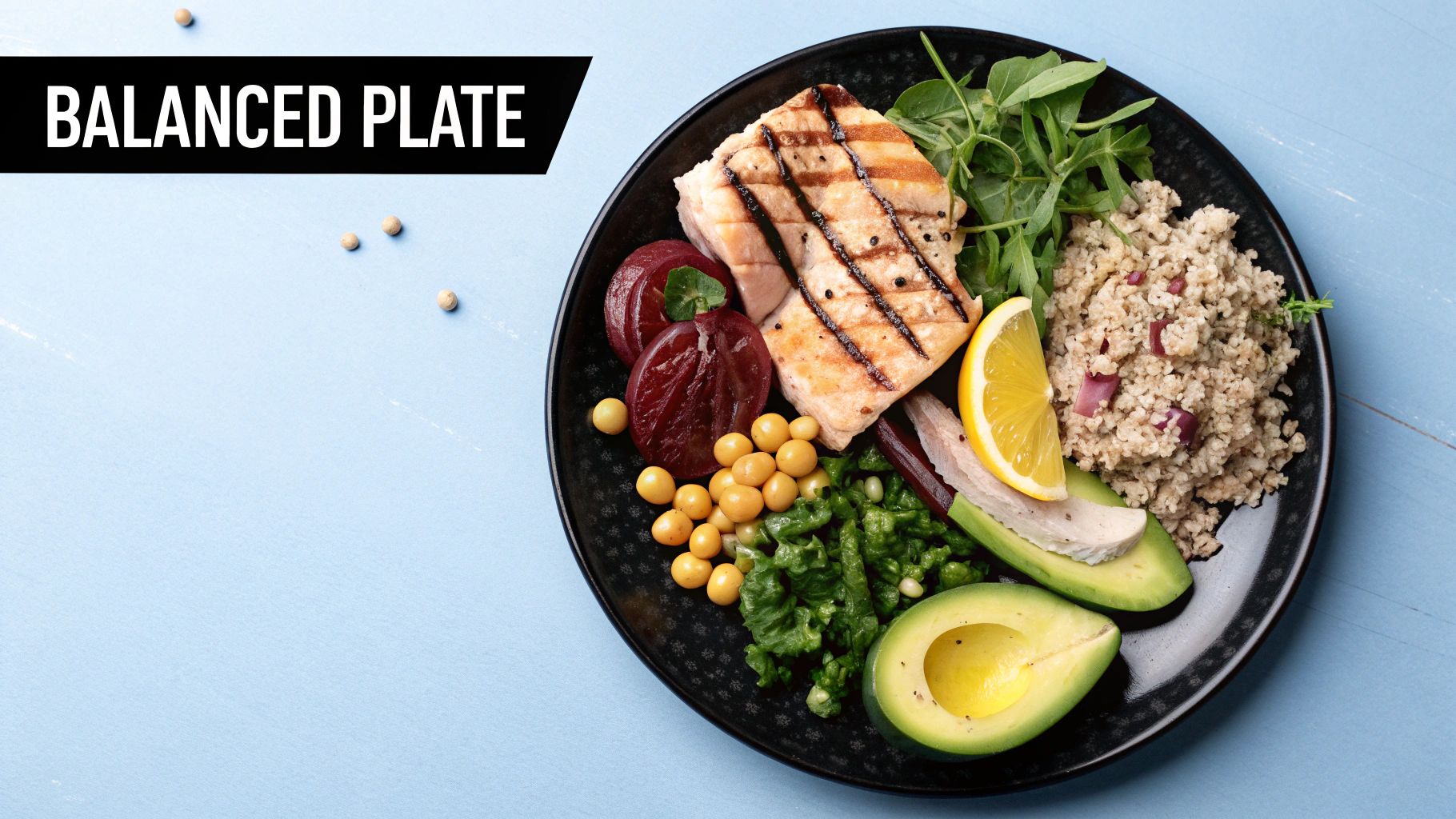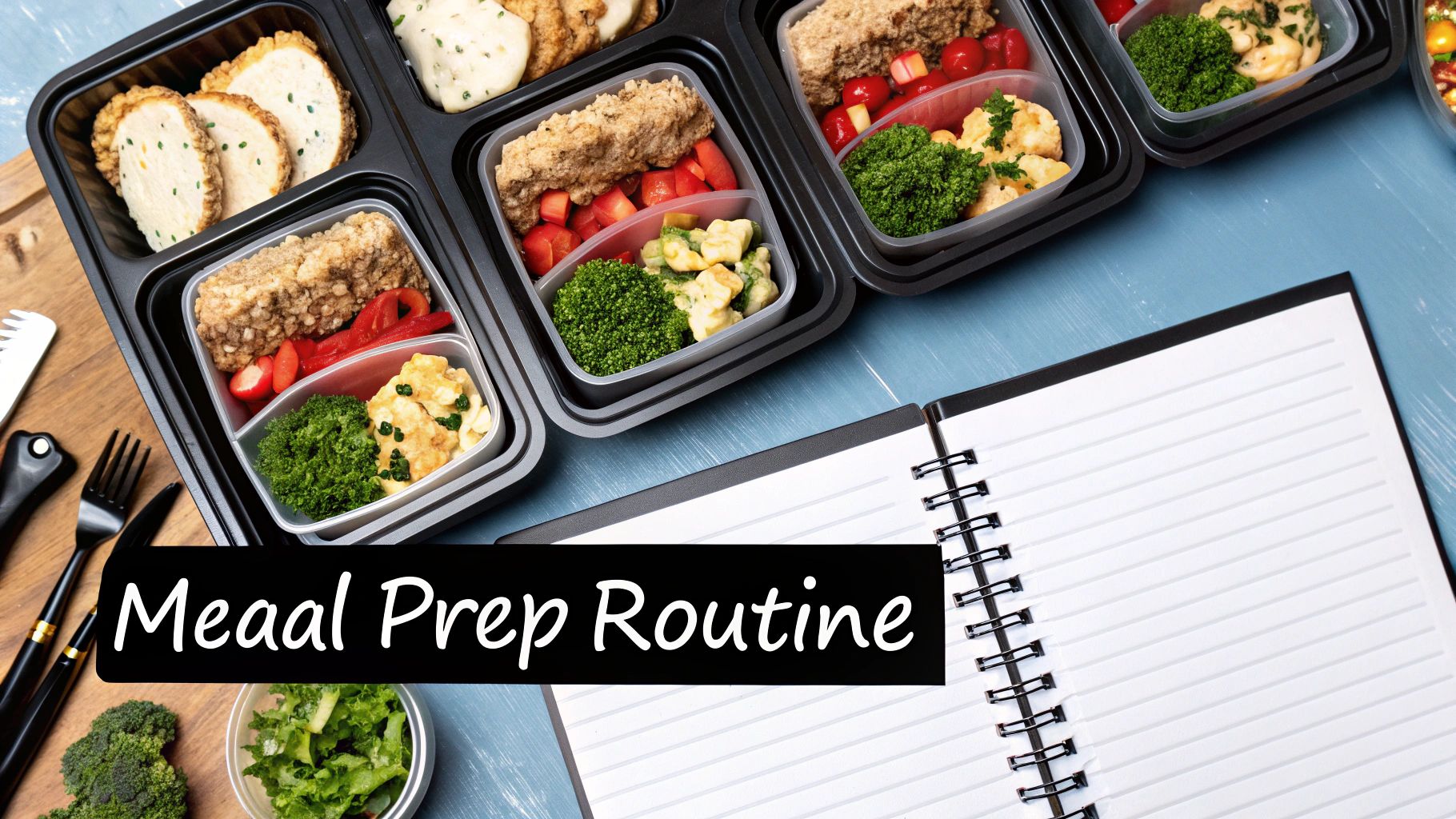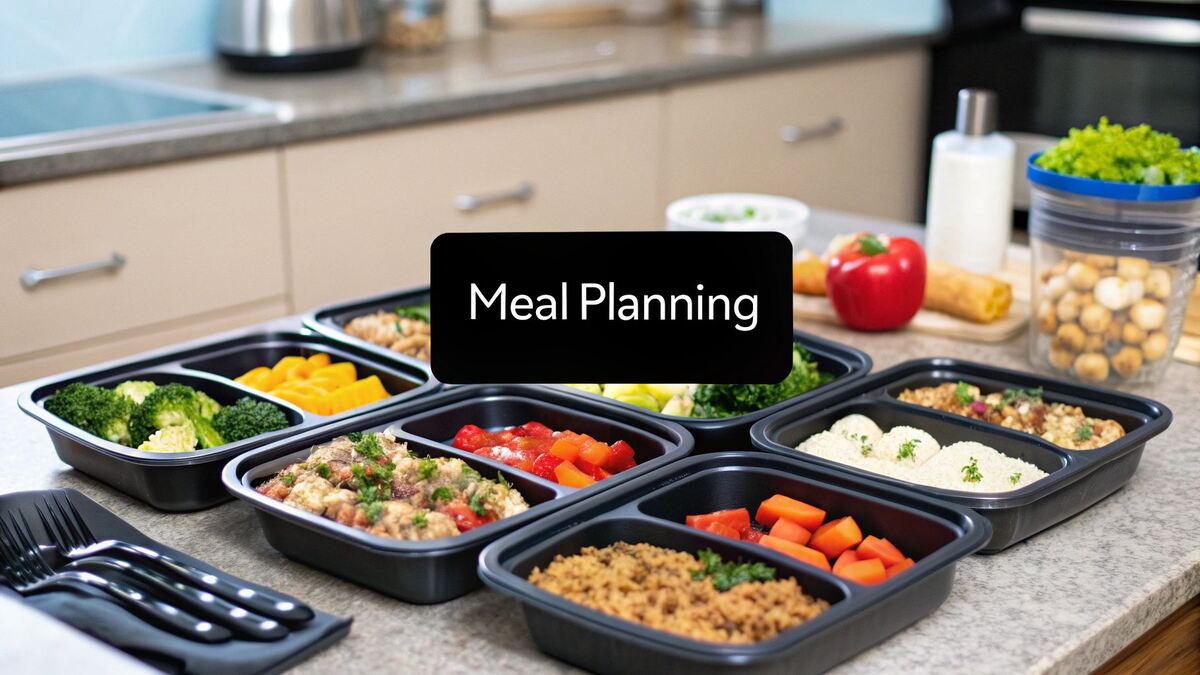Weight Loss Meal Planning Made Simple
Weight loss meal planning is simply the act of deciding what you’re going to eat ahead of time to hit specific calorie and nutrient targets. It’s a game-changer because it replaces spur-of-the-moment food choices with a clear, intentional process, making it one of the absolute best tools for finally getting to a healthy weight and staying there.
Why Most Weight Loss Plans Fail And How Yours Won't
We've all heard the advice: "eat less, move more." It sounds simple, but it rarely works on its own. Why? Because it completely overlooks something I see derail people all the time: decision fatigue.
You know the feeling. It’s 6 PM, you’ve had a long day, you’re exhausted, and you're starving. Your willpower is shot. That’s precisely when a well-thought-out meal plan becomes your secret weapon. It stops you from making that last-minute call for pizza or grabbing whatever processed food is quickest.
A successful weight loss journey isn’t about white-knuckling your way through a miserable diet. It’s about building a sustainable skill. Think of your meal plan as a roadmap. It guides your choices, gives your body the right fuel to burn fat, and completely removes the daily "what's for dinner?" stress that so often leads to bad decisions.
The global weight loss market is exploding, set to reach nearly US$590.13 billion by 2033. This isn't just a random statistic; it shows that people everywhere are fed up with generic, one-size-fits-all plans that fail them. The demand for personalized solutions—exactly what you're about to create—is higher than ever.
Building Your Foundation for Success
Real, lasting progress is born from consistency, not from being perfect. So many people get discouraged and quit because they fall into one of the common weight loss mistakes, like adopting an insanely restrictive plan they can't possibly maintain. We’re not doing that. Instead, our focus is on creating a flexible framework that actually fits into your life.
The infographic below gives a great visual of how a strategic meal plan comes together. It all starts with your personal goals and ends with delicious meals on your plate.

As you can see, it's a logical flow: understand your needs, plan your meals, shop for the ingredients, and then prepare your food. It’s a system you can repeat week after week. This entire guide is built on a few core pillars designed to make your plan both effective and, believe it or not, enjoyable.
The most effective weight loss meal plan is the one you can consistently follow. Personalization and flexibility are not just bonuses; they are essential requirements for long-term success.
To make sure this isn't just another temporary diet, we're going to build your plan around three foundational principles. These are what truly separate a quick fix from a genuine lifestyle change.
Building a plan that lasts means focusing on the right things from the start. The table below breaks down the key pillars we'll be using to construct your personalized roadmap.
Key Pillars of Effective Meal Planning
| Pillar | Why It's Important | Quick Tip |
|---|---|---|
| Personalization | A generic plan won't work. Yours must fit your calorie needs, food preferences, and daily schedule to be sustainable. | Start by listing 10-15 healthy foods you genuinely enjoy eating. We'll build your plan around these. |
| Consistency | Healthy eating becomes effortless when it's a habit. A simple, repeatable routine removes stress and guesswork. | Dedicate a specific day and time each week for planning and prepping, like Sunday afternoon. |
| Flexibility | Life is unpredictable. A rigid plan will break. A flexible one allows for dinners out and last-minute changes without guilt. | Plan for one "flex meal" per week where you can eat what you want, within reason. This helps prevent burnout. |
By keeping these three pillars at the center of your strategy, you’re setting yourself up not just to lose weight, but to build habits that will serve you for years to come.
Figuring Out Your Personal Calorie and Macro Needs
Forget those one-size-fits-all diet plans you see everywhere. The real secret to a meal plan that actually works isn't about eating boring food—it's about making it personal. Your body, your lifestyle, and your goals are completely unique, so your nutrition plan has to be, too. Before we even get to the fun part (the food!), we need to build your personal blueprint.
It all starts with nailing down your daily calorie target. Think of calories as your body's energy budget. To lose weight, you need to create a small but consistent caloric deficit. This just means you're taking in a little less energy than your body is burning each day. Simple concept, but the right number is different for everyone.
This is where your personal details come into play. Things like your age, gender, height, current weight, and how active you are all have a huge impact on your daily needs. You can find your Total Daily Energy Expenditure (TDEE)—the total calories you burn in a day—using a number of online calculators. A great first step is to calculate your Body Mass Index (BMI) with our tool to get a baseline for your current health status.
Finding Your Weight Loss Calorie Target
Once you have that TDEE number, a safe and sustainable way to kick off weight loss is by subtracting 300-500 calories from it. This creates a deficit that encourages your body to burn fat for fuel, all without leaving you feeling starved or completely drained of energy.
Let's look at a real-world example. A 35-year-old woman with a desk job who gets in a 30-minute walk every day might have a TDEE of around 2,000 calories. Her weight loss target would land somewhere between 1,500-1,700 calories per day. Now, compare that to a 40-year-old man who’s more active and hits the gym four times a week. His TDEE could be closer to 2,800 calories, putting his target in the 2,300-2,500 calorie range. See how different they are?
This shift toward personalized nutrition is only getting stronger. With more than one in eight people globally now living with obesity, people are searching for structured, tailored solutions that fit their lives. Younger generations, especially, often find weight management to be a bigger challenge, which has led to a huge demand for nutritionist-designed programs and detailed meal plans. You can see more insights on these wellness trends from McKinsey if you're curious.
Breaking It Down: Your Macronutrients
Okay, you've got your calorie target. The next move is to decide how to split that energy budget among the three macronutrients: protein, carbohydrates, and fats. Each one has a critical job to do.
- Protein: This is essential for building and repairing muscle, which is incredibly important when you're losing weight. Plus, it's great at keeping you feeling full and satisfied.
- Carbohydrates: Think of these as your body's main fuel source. Choosing complex carbs like oats and sweet potatoes will give you slow-release, sustained energy.
- Fats: Healthy fats are crucial for hormone production and absorbing key vitamins. We’re talking about the good stuff from sources like avocados, nuts, and olive oil.
For most people starting a weight loss plan, a balanced split of 40% protein, 35% carbs, and 25% fats is a fantastic starting point.
Let's take our 1,500-calorie example from earlier. Here's how that split would look in grams:
- Protein: 150 grams
- Carbohydrates: 131 grams
- Fats: 42 grams
Remember, these numbers aren't written in stone. They're your starting point—a personalized foundation you'll use to build a meal plan that's not just effective, but actually enjoyable.
How To Build a Satisfying Weight Loss Plate
Alright, you’ve got your personal calorie and macro targets. Now for the fun part: turning those numbers into real, delicious food. This is where the rubber meets the road in meal planning. We're going to build plates that not only fuel your weight loss but also kill hunger and actually make you look forward to eating healthy.
Forget the old, restrictive mindset of "good" vs. "bad" foods. Instead, let's focus on what different foods do for your body.

A truly satisfying weight loss plate isn't about eating less—it's about eating smarter. The real secret to feeling full and energized is maximizing the volume and nutrients on your plate for the fewest calories possible. Every macronutrient has a critical role to play in this balancing act.
Prioritize Lean Protein Power
Protein is, without a doubt, your biggest ally when you're trying to lose weight. It’s the most satiating macronutrient, which is just a fancy way of saying it keeps you feeling full longer and helps keep cravings in check.
It also has a higher Thermic Effect of Food (TEF), meaning your body burns more calories just digesting it compared to fats or carbs. It's like getting a small, free metabolic boost with every meal.
Your game plan should be to anchor every single meal and snack with a quality source of lean protein. This simple habit helps stabilize your blood sugar, preventing the energy crashes that lead to reaching for a sugary snack.
- Animal-Based Sources: Think chicken breast, lean ground turkey, eggs, Greek yogurt, and fish like salmon or tilapia.
- Plant-Based Sources: Lentils, chickpeas, black beans, tofu, and edamame are fantastic, fiber-rich options that pack a solid protein punch.
Embrace Smart Carbohydrates for Energy
Carbs are not the enemy! Let me say that again—they are your body's preferred source of energy. The trick is choosing the right kind. You want to zero in on complex carbohydrates that are loaded with fiber.
Why fiber? It slows down digestion, giving you a steady, slow-drip release of energy and making you feel much fuller. Think of these carbs as the premium fuel for your workouts and your brain. Simple, processed carbs like white bread and sugary junk just cause a massive energy spike and an even bigger crash, leaving you tired and hungry.
Pro Tip: Try to fill about a quarter of your plate with a complex carb. This gives you plenty of sustained energy without blowing your calorie budget. Quinoa, brown rice, sweet potatoes, oats, and whole-wheat pasta are all excellent choices.
Incorporate Healthy Fats for Hormones and Health
Healthy fats are non-negotiable. They're essential for hormone production, absorbing certain vitamins, and your overall well-being.
Yes, they are more calorie-dense than protein or carbs, but a small amount at each meal makes a huge difference in satiety. Plus, fat makes food taste better, which is absolutely crucial if you want to stick with a plan for the long haul.
Look for unsaturated fats from whole-food sources to get the most bang for your buck.
- Avocado: Adds a creamy texture and healthy fats to salads, toast, or smoothies.
- Nuts and Seeds: A small handful of almonds, walnuts, or a sprinkle of chia seeds gives you fats, fiber, and even some protein.
- Olive Oil: A go-to for salad dressings or light cooking that adds great flavor and heart-healthy benefits.
To help you see how these pieces fit together, I've put together a quick reference table. It shows the nutritional breakdown of some common foods so you can start mixing and matching with confidence.
Sample Macronutrient Food Sources Per Serving
| Food Source | Serving Size | Protein (g) | Carbs (g) | Fats (g) |
|---|---|---|---|---|
| Chicken Breast | 100g (3.5 oz) | 31 | 0 | 3.6 |
| Chickpeas | 1 cup, cooked | 15 | 45 | 4 |
| Quinoa | 1 cup, cooked | 8 | 39 | 3.6 |
| Sweet Potato | 1 medium | 2 | 26 | 0.1 |
| Avocado | 1/2 medium | 2 | 9 | 15 |
| Almonds | 1/4 cup | 7.5 | 7.5 | 18 |
This table should give you a solid starting point for building balanced meals. And if you want to take the guesswork out of it completely, you can explore our AI-powered meal generator to create custom plates based on your exact targets.
Creating a Realistic Weekly Meal Prep Routine
Alright, you've got your calorie and macro targets figured out. Think of that as knowing your destination. Now, it's time to actually draw the map that gets you there. This is where the idea of weight loss meal planning becomes a real, tangible routine that saves you stress and actually fits into your life—not some perfect, imaginary version of it.
Let's start by ditching the idea that meal prep means spending an entire Sunday chained to your stove. It's not about cooking every single thing for the entire week. It's about strategic prep that makes the healthy choice the easy choice when you're tired and hungry.

From Ideas to a Smart Grocery List
First things first: translate your meal ideas into a hyper-organized grocery list. This is your battle plan for the supermarket. Instead of wandering the aisles and falling for impulse buys that derail your progress, you'll go in with a mission. It saves you calories and cash.
I find the best way to do this is to categorize the list by the store's layout. It’s a simple trick that makes a huge difference.
- Produce: All your fresh fruits and veggies go here.
- Proteins: Think chicken breasts, ground turkey, eggs, tofu, Greek yogurt.
- Pantry: This is for your brown rice, quinoa, oats, canned beans, spices, and olive oil.
This little bit of organization can seriously cut your shopping time in half. It’s a foundational habit for an efficient workflow. To keep things organized week after week, using printable weekly meal plan templates can be a game-changer.
And you're not alone in this. The structured approach to weight loss is a massive industry. Online meal planning and consulting services account for a huge slice of that pie, generating around $20 billion annually. This just goes to show how many people are finding success by putting a solid plan in place.
Flexible Meal Prep Strategies
Look, not everyone has a free Sunday afternoon to cook up a storm. The secret is finding a prep style that syncs with your actual schedule, not the one you wish you had.
- Batch Cooking: This is for the truly time-crunched. Cook full meals in one go—a big pot of chili, a tray of roasted chicken breasts—and portion them out. Grab-and-go solved.
- Ingredient Prep: Perfect for people who prefer freshly made meals. You just do the grunt work ahead of time: wash and chop all your veggies, cook a big batch of quinoa, and whisk together a salad dressing. This lets you throw together a fresh, healthy meal in minutes.
Here's a pro tip: Don't try to prep five completely different lunches for the week. You'll burn out. Instead, go for a "mix-and-match" approach. Prep two proteins (like chicken and chickpeas), three versatile veggies (like bell peppers, broccoli, and spinach), and one carb source (like brown rice). You can create different bowls and salads all week without getting bored.
A 3-Day Sample Plan in Action
So, how does this all come together? Let's walk through a simple, balanced plan. This isn't a rigid diet to follow verbatim; it's a flexible template you can make your own. For more personalized ideas, you can always explore our complete balanced meal plan guide.
Here’s a quick snapshot of what a few days could look like for someone aiming for around 1,600 calories.
3-Day Weight Loss Meal Plan Example
| Meal | Day 1 | Day 2 | Day 3 |
|---|---|---|---|
| Breakfast | Oatmeal with berries & nuts | Greek yogurt with berries | Oatmeal with berries & nuts |
| Lunch | Grilled chicken salad with vinaigrette | Leftover Chicken Fajitas | Quinoa bowl with black beans & avocado |
| Dinner | Sheet Pan Chicken Fajitas | Baked salmon with sweet potato | Leftover Chicken Fajitas |
| Snack | Apple with peanut butter | Hard-boiled egg | Handful of almonds |
How To Stay Consistent and Navigate Real Life
Let's be honest: even the most perfectly crafted meal plan is going to run head-on into real life. It’s inevitable. Office birthdays, last-minute dinner invites, and those late-night snack cravings aren't just possibilities—they're guaranteed to happen.
The secret isn't trying to build a fortress around your plan. Success with weight loss meal planning comes from building a flexible playbook that helps you navigate the real world, not hide from it. It's all about consistency over perfection, and that means having a strategy for when life gets in the way.
Winning at Social Events and Dining Out
Social gatherings are probably the biggest test for any healthy eating plan. But you don't have to turn down every invitation. With a little bit of prep work, you can stay in control without missing out.
Before you even leave the house for a restaurant, always look up the menu online. Seriously, this five-minute trick is a game-changer. It lets you find the best options when you're calm and not staring down a basket of bread while you're starving. Look for keywords like "grilled," "steamed," or "baked," and try to build your meal around a lean protein and a pile of veggies.
Heading to a party or potluck? Offer to bring a healthy dish you actually love to eat. A big, vibrant salad, a tray of roasted vegetables, or some chicken skewers ensures there's at least one fantastic option you can load your plate with, no questions asked. It's a simple move that puts you back in the driver's seat.
Your goal isn't to be perfect; it's to be prepared. One off-plan meal won't undo your progress, but a consistent lack of a strategy will. Flexibility is your greatest asset for long-term success.
Managing Cravings and Bouncing Back
Cravings are going to pop up. The trick is to have a plan for them before they strike. A lot of the time, what feels like a craving is actually your body telling you it's thirsty. Try downing a big glass of water first and wait a few minutes.
If it’s a real craving that won’t quit, have a healthier swap ready to go. Got a sweet tooth? Try some Greek yogurt with berries. Need something salty and crunchy? A small handful of salted almonds usually does the trick.
But what happens when you do slip up? It’s going to happen, and it’s okay. The all-or-nothing mindset is a trap that leads to quitting. Don't spiral. Just acknowledge it, forget about it, and get right back on track with your next planned meal. No guilt trips, no "making up for it" at the gym—just get back to the plan.
Finally, remember to look beyond the number on the scale. Tracking non-scale victories is a huge motivator.
- Are your clothes fitting a little looser?
- Do you have more energy to get through the afternoon slump?
- Are you sleeping better at night?
These are the real wins. They're tangible proof that what you're doing is working, and that's the kind of encouragement that keeps you going for the long haul.
Common Meal Planning Questions, Answered
Starting any new health kick comes with a lot of questions. I get it. Think of this as your go-to guide for troubleshooting the common sticking points you might hit while planning your meals for weight loss.
Let's clear up the confusion so you can move forward with confidence.
How Long Should I Stick to the Same Meal Plan?
This is a great question. You want to aim for consistency, but not monotony. I've found the sweet spot is following the same structure—your calorie and macro targets—for about 2-4 weeks.
This gives your body enough time to adapt and for you to actually see what's working.
That doesn't mean you're stuck eating the same chicken and broccoli every single day. Far from it! You should absolutely swap in different recipes each week to keep things interesting and make sure you're getting a broad spectrum of nutrients.
Think of your meal plan as a flexible blueprint, not a rigid set of rules. If you're getting bored, change the recipes. If your weight loss stalls for a couple of weeks, it's time to revisit your calorie and macro numbers.
What if I Don't Have Time for a Big Weekend Meal Prep?
Life is busy, and spending a whole Sunday chained to the stove isn't realistic for most people. The good news is, you don't have to. You can get most of the benefits with a fraction of the time by focusing on ingredient prep.
Instead of cooking full meals, just prepare the individual components that take the longest. This way, you can throw together a fresh, healthy meal in minutes during the week.
Here’s what that looks like in practice:
- Grains: Cook up a big batch of quinoa or brown rice to use all week.
- Protein: Grill a family pack of chicken breasts or hard-boil a dozen eggs.
- Veggies: Wash, chop, and store all your vegetables so they're ready to grab.
This simple shift in strategy means you can assemble a meal in less than 15 minutes. It’s a total game-changer.
Are Snacks Allowed?
Yes, you can and should have snacks! When done right, snacks are your secret weapon for managing hunger, keeping your energy stable, and preventing you from getting so ravenous that you overeat at lunch or dinner.
The trick is to plan them. Just like your main meals, snacks need to fit into your daily calorie and macro budget.
Forget mindless grazing. Intentionally choose snacks packed with protein and fiber to keep you full. A few of my go-to options are Greek yogurt with a handful of berries, an apple with a spoonful of peanut butter, or some cottage cheese. Planning ahead stops you from grabbing a bag of chips when that 3 PM hunger hits.
Ready to stop guessing and start building a plan that actually works for you? The AI Meal Planner creates personalized meal plans based on your specific goals, preferences, and dietary needs. Take the guesswork out of meal planning and get your custom plan now at https://ai-mealplan.com.
AI-powered nutrition
Get Your Personalized Meal Plan
AI creates the perfect meals for your goals, lifestyle, and taste.
Start Your Journej
